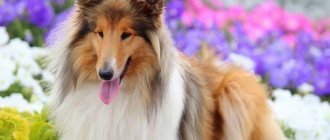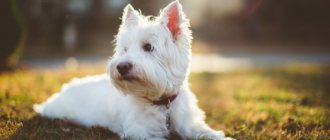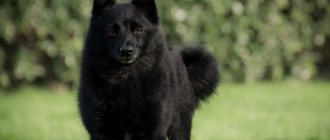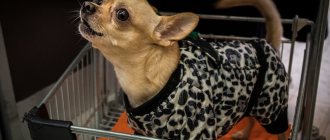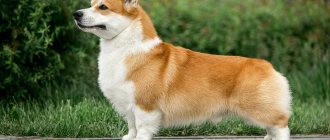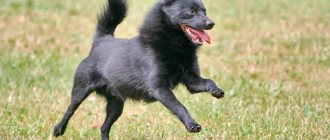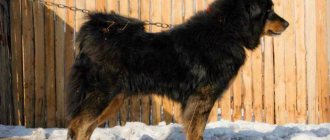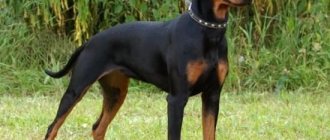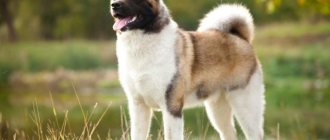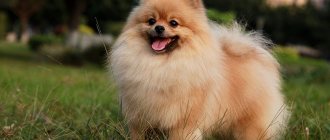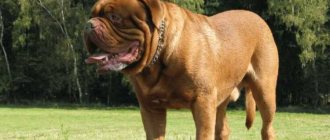A guide dog is an indispensable companion for a person with visual impairments. However, not every breed will be suitable. When selecting applicants, the coach must pay attention to such character traits as:
- easy learning;
- ability to concentrate;
- patience;
- excerpt;
- mental stability;
- friendliness.
Aggression and security qualities are unacceptable for guide dogs. Otherwise, they will pose a threat not only to others, but also to the owner himself. Guides can only warn about danger. Following a given route just half a length ahead, they take into account not only the permitted places for crossing the road, holes and curbs, but also pay attention to branches and low-lying electrical wires. In a word, such a companion for a blind person is simply irreplaceable.
Every dog is subject to education and training, but during long training only a select few remain. Some breeds have gained the greatest popularity due to character traits inherent in nature. However, you have to choose not only based on personal preferences: the dog must be of suitable height so that it is easy for a person to hold the harness. Let us next consider the most popular breeds, proceeding from the tallest to the shorter brothers.
German dog
This is a noble, large dog, which, due to its height (80-90 cm at the withers), is more suitable for adults than for children. They are proud and proud, however, these qualities do not prevent them from faithfully and loyally serving their owner and helping him even in difficult situations. The Great Dane is an easily controlled and trainable, obedient dog. They do not pay attention to external provocations and remain calm and self-controlled, however, they treat suspicious strangers with distrust, protecting the person.
They are not always easy to train: commands are learned slowly compared to other breeds, but if the pet remembers it, then it is forever. It will take 3-4 times to remember the route. A special mindset and sense of responsibility allows you to process a large flow of information, analyze it and make an informed decision. You can undoubtedly trust this dog with your life. Having completed the main tasks, they prefer to relax near the owner, enveloping him with their love and warmth.
Saint Bernard
These large dogs (up to 70 cm at the withers) have the same big and kind hearts, prudence and rescue skills. A kind of hero of our time. Behind the thick fur and deep brown eyes lies excellent self-control and a willingness to always come to the aid of its owner. However, not everyone can find an approach to a St. Bernard - a dog will be able to fully open up and love a person if it becomes a real member of the family. Thus, a person acquires not just a guide, but a true, faithful friend.
Giant Schnauzer
This is a fairly large breed, reaching a height of 70 cm at the withers, so it is more suitable for an adult. In terms of their performance characteristics, they are in no way inferior to the German Shepherd, which is why they are often used for official purposes. Phenomenal memory, the ability to remember a large number of commands, balance and devotion make it possible to grow a Giant Schnauzer into an ideal guide for a person with disabilities. They are a reliable support and support for their owner. As a pleasant bonus, one can highlight their friendliness and cheerful disposition, which means that they will get along well with members of the household, including the smallest ones.
Read Top 20 cutest dogs in the world with photos
Purpose
Not every dog can become a guide dog. Half of the students drop out during the first classes. Guide dogs must have certain personality traits, including being friendly towards people. The best guides grow from puppies whose parents served as blind people, since their natural qualities are enhanced by genetic memory.
Guide dogs perform the following functions:
- accompany a blind person along the chosen route;
- help a disabled person adapt to environmental conditions;
- ensure the safety of the owner;
- provide psychological support.
When leaving the house, the dog begins to take care of the person so that he does not get into trouble. The dog barks to warn of obstacles along the way, including puddles, traffic lights, benches, stairs, and closed doors. In addition, such animals know how to look for the entrance, the way back from the metro, and pick up things dropped by the owner. Another task that the guide must perform is to remember the most common routes and lead the blind person to the right place without deviating from the path.
Doberman
These active guide dogs require daily long walks and games to maintain good physical shape and health, so they are more suitable for children and young people with visual impairments. It is difficult to imagine the Doberman as a companion and companion, but they have proven themselves well due to their desire for training and balanced character. A calm and friendly dog quickly takes a defensive position if its owner is in danger. They are sociable, but will not bother their owner if they are in a bad mood. They adapt and go through all the difficult moments together, so they become not just a dog leading through the roads and streets, but a real loyal friend. The height of an adult is 65-75 cm.
Bernese Mountain Dog
These are hardy, active, peace-loving and cheerful dogs that are ready to give their blind owner a boost of energy and happiness. However, once on the street in a specialized harness, the funny pet will be unrecognizable. He instantly transforms into an obedient, balanced and reasonable dog, clearly in control of his surroundings. It is quite easy to train, but you have to be persistent.
Features of addiction
Transferring the animal to a new owner is the third and very important stage, which is called habituation. It is at this moment that it becomes clear whether they are suitable for each other. A guide dog spends a long time learning to lead a blind person down the street. During the adjustment period, the dog handler will be close to the dog and the disabled person.
The new owner needs to spend as much time as possible with their pet. A guide dog is no different from ordinary dogs; he also loves praise and will be happy to receive a treat for obedience. This is important to consider during the adaptation stage. You need to talk to your dog as often as possible so that it remembers your voice. Cases where the owner and the dog do not suit each other are very rare.
Chesapeake Bay Retriever
These dogs are real hard workers. They are strong, resilient and tireless, but willful, and for a dog to fully reveal all its positive traits, a firm hand from the owner is needed. Having won the trust of a Chesapeake, a person finds a devoted friend who will become a companion on a long journey and help cope with daily everyday difficulties. They are attentive, kind and active, and these are perhaps one of the most important characteristics for dogs.
Rottweiler
The main quality for which this breed of guide dogs is valued is endless devotion to its owner. Their highly developed intuition, physical strength and speed have made them more than just a companion for many disabled people. They became protectors and guards. Patient and hardy, they will become an indispensable assistant in everyday tasks, and their developed intelligence and quick wits allow them to learn new tasks literally every day. However, the Rottweiler is not suitable for everyone: he has a tendency to dominate, so in order to get along and get along with him, you must have a strong and strong-willed character. When going outside, these dogs must be muzzled.
Read Dogs that look like a fox - 20 breeds with examples of similarities
German Shepherd
German Shepherds have long earned a special place in the hearts of dog owners. This is not just a friend, but a real comrade-in-arms, to whom you are not afraid to entrust your life. They will be devoted and faithful until their last second.
The brilliant successes of the German Shepherd in a variety of activities were not slow to attract attention. These dogs perform daily feats as a police or border dog, but are also excellent guide dogs. Cheerful, brave and energetic, they endlessly delight their owners and household members, and their intellectual abilities allow them to learn a large number of commands.
Height 55-65 cm.
Boxer
A formidable appearance, a muscular body, a tall height of 55-65 cm rather causes fear among others, but few people realize that hidden behind the outer shell is the most faithful and kind friend, ready to play with household members and children. Boxers are smart and easy to train, mastering dozens of new commands in a short time. As a guide dog, this breed is suitable for people of average height.
The cost of the animal and the right to receive
Guide dogs are provided free of charge to everyone with group I visual impairment. But you will have to wait your turn, which usually takes about 6 months. For those who don't want to wait, you can buy an animal.
The price for a guide dog ranges from 250-400 thousand rubles. The second option is to purchase the animal yourself and send it to training. The cost of training is approximately 60 thousand rubles.
Tervuren
This breed has the most important qualities for guide dogs:
- training speed;
- obedience;
- attentiveness;
- bravery;
- ability to analyze a situation and make a decision;
- activity and good character.
Having become a loyal friend and support for a person with disabilities, he will become a brave defender. Tervurens prefer to be the only favorite in the family, so it is better to refuse other animals, but they always feel warm love for children.
They have a strong character, so it is important to start raising them from the very first moments of acquaintance.
Availability
Guide Dog Israel
Despite regulations or rules prohibiting access to animals in restaurants and other public places, in many countries service animals are protected by law and therefore can accompany their handlers in most places open to the public. Laws and regulations vary around the world:
- In the United States, the Americans with Disabilities Act prohibits any business, government agency, or other organization that provides access to the general public from prohibiting the use of service animals unless their presence would pose a health or safety risk. However, religious organizations are not required to provide such access. Whether service animals in training have the same rights or not is usually up to each state government. In addition, the Fair Housing Act requires that landlords allow tenants to have service animals, as well as other types of service animals, in residential buildings that generally have
a no-pet
policy and that such tenants cannot be charged additional fees. The Department of Housing and Urban Development's Office of Fair Housing and Equal Opportunity investigates complaints from the public alleging denials of reasonable accommodation requests related to animal assistance. - In the United Kingdom, the Equality Act 2010 provides that disabled people have the same right to services provided by shops, banks, hotels, libraries, pubs, taxis and restaurants as everyone else. Providers to accommodate service animals and service animal owners. Under Part 12 EA, it is illegal for service animal owners to deny access to a taxi or mini-cab with their service animal, but medical benefits are available if drivers have a certificate from their GPs.
- In most South American countries and Mexico, access to service animals depends solely on the goodwill of the owner or manager. In areas with a lot of tourists, service animals are usually accepted without problems. In Brazil, however, a 2006 federal decree requires that service animals be allowed in all public places. Metro Brasília has developed a program that trains service animals to ride on it.
- In Malta, the Equal Opportunities Act 2000 (Cap. 413) states that it is unlawful to discriminate against a person with a disability who requires an assistant, in this case a service animal. The exceptions are restaurant kitchens, special hospital rooms, toilets and rooms where other animals are kept.
- In Australia, the Disability Discrimination Act 1992 protects service animal owners. Each state and territory has its own laws, which may vary slightly.
- In Canada, service animals are allowed wherever the general public is permitted. Service Animal Laws by Province: Alberta: Blind Rights Act, Service Dog Act
- British Columbia: Guide Animal Act
- Manitoba: Human Rights Code, Service Animal Protection Act
- New Brunswick: Human Rights Act
- Newfoundland and Labrador: Blind Rights Act, Human Rights Act
- Northwest Territories: Human Rights Act
- Nova Scotia: Blind People's Rights Act, Human Rights Act
- Nunavut: Human Rights Act
- Ontario: Blind People's Rights Act, Accessibility for Ontarians with Disabilities Act, Human Rights Code
- Prince Edward Island: Human Rights Act
- Quebec: Persons with Disabilities Act, Charter of Human Rights and Freedoms
- Saskatchewan: Human Rights Code
- Yukon: Human Rights Act
Collie
If you are looking for an intelligent, beautiful and calm seeing-eye companion, you should pay attention to this breed. Kind, loyal and active - they are perfect as a helper for children. They sense a change in their owner's mood and patiently wait to be called for help. Carrying out old commands, learning new ones, and helping the owner give true pleasure to dogs. Originally a herding dog, they will guard and protect their owner, and will remain loyal to him forever.
Labrador Retriever
This is one of the most common breeds of guide dogs - more than 80% of people with visual impairments choose them as a companion. They are patient and friendly, which allows them to quickly switch from an instructor to a new owner and quickly establish contact. In addition, their height (50-60 cm) is considered the most convenient for carrying in a specialized harness.
This smart and quick-witted dog is easy to train and remembers new routes, which is an undeniable advantage for this breed. Labradors are long-lived dogs. If they follow the rules of care and provide good nutrition, they live up to 18 years, helping their owner every day in performing even complex tasks.
Guide dog schools in Russia
There are very few places where guide dogs are trained in Russia. In some sources you can find a statement that the school in Kupavna is the only one, but in fact this is not the case. You can find a list of such centers below.
| City | Name of the organization | Website |
| Moscow | “Russian school for training guide dogs of the All-Russian public organization of disabled people “All-Russian Order of the Red Banner of Labor Society of the Blind”” (RSHPSP VOS) | sobakaprovodnik.ru |
| Moscow | Training and cynological center “Assistance dogs for the disabled” | www.guidedogs.ru |
| Saint Petersburg | Training school for assistance and guide dogs "Eva" | canistherapy.com |
Golden retriever
Representatives of this breed of dogs are wonderful companions and helpers who are ready to serve their owner day and night. They are sociable and friendly, but at the same time they perfectly sense the mood of those around them and will not impose their company at the wrong time. Smart, flexible, highly intellectually developed, which makes it possible to raise them as a devoted companion. Golden Retrievers are not prone to dominance, so they are perfect for someone who is getting a dog for the first time, but it is important to remember that their coat requires careful care. Height does not exceed 50-58 cm.
Read Short-legged dogs - top 20 breeds
Airedale
This is an incredibly smart and quick-witted breed that is quite easy to train and remembers new routes. Helping their owner every day, they become irreplaceable guides. They are brave and strong, and with a certain special upbringing they will not show aggression in any way and will be friendly if nothing threatens their life and health. Sociable and overly self-confident, he is more suitable for a powerful person with a strong character.
Methods of preparation for work
The main task of guides is to study and remember routes so that the owner can easily get to the desired point, be it a store or work. In order for the dog to cope with its duties, it is taught the following commands:
- moving in front of the owner, turning;
- stopping when obstacles appear and further walking around (in this case, the dog must notify the owner about the obstacle).
Command training is carried out at training grounds with the help of professional dog handlers. A man holds a cane for the blind in his hands and moves along a trajectory. When an obstacle appears, the command “Stop” is given and the trainer hits the obstacle with a stick. Training is carried out until the animal begins to respond correctly to commands. When the dog learns to cope with these tasks, they move on to the next stage - moving between objects, going up and down stairs, driving along the streets. Students are taught basic commands and the names of various places: house, store, park.
Poodle
The Royal or Standard Poodle grows 45-60 cm and has a kind, unpretentious disposition. A trained dog is suitable even for a novice dog breeder. Observation and interest in interacting with a person facilitates the learning process. They easily remember new routes and unquestioningly and happily follow their owner’s commands. If a person needs the help of a dog, he immediately rushes to the rescue and does everything possible to make the owner happy and satisfied. In addition, they will not let you get bored, actively supporting the games, and are happy to make contact.
Great mission
It is known that for more than one millennium, faithful four-legged animals have been helpers, guides and protectors for people deprived of sight. However, this officially began to be done in 1819 in Vienna. Then an institute was founded for the education and training of the blind. After World War I, Germany developed a special training system for dogs that helped blind people, in particular veterans who had lost their sight as a result of combat. At the same time, the English school is developing, one of the founders of which was the Russian emigrant Nikolai Lyakhov, who went from trainer to director of the institution.
Did you know? Dogs are often more effective detectors than humans. Thus, it is believed that one dog can replace up to three dozen people in search operations. The fact is that a dog’s sense of smell is 25 times better than a person’s, and even the brain center responsible for processing odors is larger in volume. Not a single device created by mankind can compete with a dog’s sense of smell in analyzing odors. Interestingly, animals with dark and black noses distinguish odors more acutely than dogs with light nasal mucosa.
In 1929, a similar organization appeared in the United States thanks to breeder Dorothy Eustis. Her article for the Saturday Evening Post inspired people with vision problems to use dogs. So, one of the Americans, Frank Morris, visited Europe to purchase a trained animal. Upon returning to America, they organized a tour of the country, where they demonstrated to people the amazing abilities of trained animals. This helped four-legged guide dogs gain access to transport and public places (hotels, cafes, restaurants, shops), where they were previously prohibited from appearing.
On the territory of the USSR, dogs began to be trained for such an important mission after World War II, in 1947. The training was carried out by specialists from the Central School of Service Dog Breeding. The need for assistance dogs for disabled people has increased sharply, since after the war many young people suffered severe visual impairments, although they were physically healthy and strong, and were also valuable specialists in various fields. 13 years later, the Central Republican School was opened in the Moscow region, in which former officers and dog handlers trained guide dogs.
Assistance dogs for disabled people perform a number of important functions:
- The main function of a service animal is to warn the owner about obstacles and dangers: open hatches, holes, branches and trees, fences, vehicles and others.
- Able to remember the main routes used by the owner, also finds landmarks (stairs, benches, other signs and indicators).
- If the owner often takes new routes, the animal helps to follow the rules: bypasses other pedestrians, slows down at forks, in front of the roadway.
- The animal will come to the rescue if the owner has dropped his things: a cane, glasses.
Important! One of the key functions of a dog is psychological and moral support for a blind person. After all, blind people are often lonely, and the dog replaces their relatives, friends, acquaintances
Naturally, both man and dog need time to get used to each other, learn to hear and understand
It is important for the owner to adequately assess the dog’s abilities and capabilities, not to expect more than the norm from him, then his hopes for the animal’s help will be fully justified.
Aussie
Aussies have earned popularity for their intelligence and endurance. Balance and quick assimilation of commands allow them to undergo specialized training in the shortest possible time and unquestioningly carry out human commands. They are patient, friendly and good with children. However, their fairly tall stature makes them good companions mainly for adults.
This breed requires careful grooming, and in gratitude they respond with strong friendship and loyalty.
Hungarian Vizsla (Hungarian pointing dog)
With a toned, athletic build, the energetic Vizsla has a reputation as an excellent hunting dog and loyal companion.
Despite his kind, easy-going disposition, this dog is always ready to defend his person. Another advantage of this breed is its ease of training. The dog's intelligence and obedience make it a pleasure to train.
The Vizsla is a very active and hardworking breed that requires a lot of physical activity.
Labradoodle
These intelligent and sociable dogs were bred by crossing a Poodle and a Labrador. They took the most important characteristics from their ancestors: energy and love of life from the Labrador, a soft, easy-going character, quick learning, and most importantly, non-shedding coat from the Poodle. The latter quality allows them to be given to allergy sufferers and children with weakened immune systems.
These dogs cannot imagine their existence without their beloved owner and will fill his life with boundless love and devotion. After completing a course of specialized training, they become excellent guides and warn people from danger.
Goldador
The two most popular breeds most commonly used as guide dogs are the Golden Retriever and the Labrador Retriever. Recently, they are increasingly being crossed to produce a hybrid that combines the best qualities of both breeds to help visually impaired people.
The positive aspects of the hybrid include:
- ideal temperament – balanced, focused, not too energetic;
- stress resistance;
- sociability (the dog is not distracted by other pets and people while working);
- lower grooming needs than pure goldies;
- not as high a need for exercise as pure Labradors;
- excellent health and longevity.
Russian Spaniel
The Russian Spaniel is perfect for any family. These dogs adapt perfectly to the conditions of a small apartment, quickly get used to it and from the very first seconds begin to help their owner. They are smart, easy to train and will happily follow a command, which is typical of all spaniels. Loyal, kind, reliable, dutiful - these characteristics best describe the representatives of this breed. Small and quite active, they definitely won’t let you get bored and will become an integral part of everyone’s life.
Boundless love for humans, devotion and fidelity make representatives of the listed breeds the best friends who will always help in a difficult situation.
